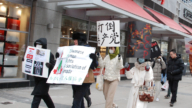【新唐人2011年5月25日讯】大陆媒体报导,中国高速公路的收费和管理成本偏高,造成物流成本降不下来,也抬高了米价、菜价,造成民众生活负担。有媒体指出,官商一体,绝对权力造就的组织文化,才是各种不合理收费的问题来源。
《广州日报》5月23号报导,河南高速公路洛阳分公司,负责一百公里左右的公路收费员工,就有403个。报导指出,洛阳分公司主要负责收费管理,不用负责路线规划、道路施工等,平均每公里4个人负责好像太多了,不过这还不是最多的,比如沪宁高速公路每公里由5.4个人负责管理,成本更高。
不只如此,各地路桥费偏高也引发关注。上周末《世界新闻网》报导,截至5月18号为止,网民票选出了收费排行榜的前五名所谓“摇钱树”,分别是:浙江台州椒江大桥、河南漯河收费站、河南郑州黄河大桥、浙江金华白龙桥收费站,加上济南黄河大桥。
但是如椒江大桥总投资3亿2000万元,自2001年12月12号起收取车辆通行费,日通车量2万5000辆。知情人士指出,收费站每天收入约25万元,十年早就连本带利赚回来了。
虽然官方回应说,这些收费是有合法“依据”的!不过网民批评:本来就用纳税人的钱修路,够本就行了,凭什么还要赚我们(人民)的钱?山东大学哲学与社会发展学院马广海教授也向媒体表示:油价飞涨,路桥收费高,生活成本上升,加上各种罚款,民众怨言越来越多。
《西安晚报》深入调查发现,物流成本太高,造成蔬菜一边批发价贱,一边零售价贵,“菜贱伤农”和“菜贵伤民”两种矛盾现象同时发生。
比如西葫芦在山东产地价格5分钱一斤。一路运到北京菜市场后,价格上涨20倍。这个月(5月)17号《第一财经日报》报导,2009年农副食品加工业物流成本约占12.9%,其中运输成本就超过一半,占54.9%。这个月(5月)中国物流与采购联合会发布的最新数据显示,去年(2010年)中国物流总费用占国内生产总值约18%,“物流成本偏高”也是商品价格抬高的重要因素之一。
过路费太高同样让不少“非公务车”车主绕行省道或村道,造成物流成本降不下来,抬高了米价、菜价。欧美用来提升民众生活的高速公路,移到中国反而增加民众生活负担。虽然最近官方有研议要降低路费?不过《西安晚报》的记者质疑:这么多人靠公路吃饭,所谓“最后一公里”的物流成本降的下来吗?
《广州日报》指出,问题根源于中国现有的“官商一体文化”。比如湖南怀新高速公路管理处斥资170万元要盖“镇妖塔”,兰州路桥费收费管理处更抢在“五部委取消公路养路费”实施前,没通过就想“预征”2010年全年路桥费。
报导指出,仔细研究这两个单位的性质,他们的上级都是“N块牌子、一套班子”的官商一体式单位。在缺乏制衡下,决策者自然可以把稳赚不赔的“好生意”按照部门、系统来分配,或把事关国计民生的产业留给亦官亦商的企业。最后形成特定人士的印钞机、提款机,或亲友就业站。在中国,类似的“官商一体”单位从油到电,从烟到盐,数也数不清。
新唐人记者曾耀贤、王明宇综合报导。
One Highway Uses 400 Toll Collectors
According to China’s state-run media,
travelling on China’s highways’
could cost you dearly in tolls and other charges.
As the cost of managing China’s highways increases,
so do the logistical costs, which in turn
raises the prices of rice, vegetables, and other goods.
This extra financial burden directly affects
the lives of everyone who uses the highways.
Some media pointed out that the reason toll charges
are so high is due to the collaboration between
officials, businesses, and the organization structure
of absolute power.
Guangzhou Daily reported on May 23 that Henan
Express Company Luoyang Subsidiary has 403 staff
in charge of approximately 62 miles of highway.
According to the report, the Luoyang Subsidiary
only deals with toll administration and has nothing
to do with route planning or road construction.
So an average of four staff per every .62 miles,
is too many. Shanghai-Nanjing Expressway has an
average of 5.4 staff per .62 miles and the toll costs
are even higher.
Moreover, people are suspicious
of the high bridge tolls, and often talk about them.
World Journal reported last weekend that on May 18,
China’s netizens selected the top five
“most profitable” toll bridges in China, which are:
Jiaojiang Bridge in Taizhou, Zhejiang,
Luohe Toll Station in Henan,
Huanghe Bridge in Zhengzhou, Henan,
Bailong Bridge Toll Station in Jinhua, Zhejiang,
and the Huanghe Bridge in Jinan.
However, the total costs involved in constructing
these bridges was not very high.
For example, it only took about 5 million dollars
to construct the Jiaojiang Bridge.
Considering the daily flow of about 25,000 vehicles,
since December 12, 2001, an insider revealed
that the toll stations’ daily revenue is around $38,000.
Thus, the authorities can get back both their principal
and interest in 10 years.
Although the authorities say that these charges
have a legal basis, netizens still complained:
“Taxpayers pay for the construction of the highways
thus, the authorities shouldn’t charge more than
the total investment of the toll bridge. So why are they
making money on us people?”
Professor Ma Guanghai from Shandong University
told the media: “People are complaining about
soaring oil prices and bridge tolls, which in turn raises
the cost of living, along with a multitude of fines.”
According to an investigation conducted by the
Xi’an Evening News, high logistical costs
have resulted in low wholesale prices and
high retail prices of vegetables,
which equally affect both farmers and customers.
For example, the actual costs involved in growing
marrow squash in Shandong Province rises
20 times after the vegetable is transported to Beijing.
China Business News reported on May 17
that in 2009, logistical costs accounted for 12.9 percent
of the total costs of all farm products, with 54 percent
of that 12.9 percent being spent on transportation.
According to China Federation of Logistics and
Purchasing’s latest data, in May of last year,
China’s total logistical costs accounted for
18 percent of the gross domestic product (GDP),
which was the main reason
for the high costs of retail goods.
The high toll bridge charges also cause
many “unofficial cars” to travel along rural roads
thus helping to keep the logistical costs high,
which in turn raises the prices of rice and vegetables.
In Western countries, highways improve people’s lives.
But in China, highways make people’s lives harder.
Although the authorities have discussed cutting tolls,
Xi’an Evening News’ reporters asked, “How could the
logistical costs, known as the ‘last mile’, actually drop
when so many people are making a living
on highway tolls?”
Guangzhou Daily pointed out that the problem exists
due to the “collaboration between officials
and businesses” in China.
For example, the Huaixin Highway Administration
in Hunan, spent $261,000 to build a “Zhenyao Pagoda.”
But the Lanzhou Toll Administration “pre-collected”
2010’s annual tolls in 2009 without permission, right
before the “cancellation of highway maintenance
fees for five ministries” was put into force.
According to the report, the supervisors of these two
institutions had numerous ties with officials and
businesses. With minimal regulation and oversight,
the people in charge can freely distribute the profits
to different businesses, departments, and systems,
or they can leave the business to
bureaucratic merchants, thus affecting the welfare
of the masses. Finally, these businesses naturally
become “cash-cows”, money printing machines, or
cash dispensers, or serve as employment centers
for their relatives. In China,
these bureaucratic-merchant businesses are countless:
from oil to electricity, from cigarettes to salt.
NTD reporters Zeng Yaoxian and Wang Mingyu





























